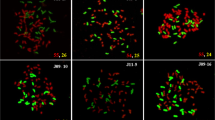Abstract
When eight cultivars of Capsicum annuum were used as female parents in interspecific crosses with two accessions of C. chinense, dwarfism occurred in hybrids originating from 10 out of 16 combinations, while hybrids of the remaining 6 combinations grew normally. In contrast, when C. chinense was used as female parent, all of the hybrids showed severely stunted growth as if affected by a virus. These results suggested that the stunted growth expressed in the cross of C. chinense x C. annuum is caused by an interaction between nuclear gene(s) from C. annuum and the cytoplasm of C. chinense. To examine the number of nuclear gene(s) which cause(s) the stunted growth, we backcrossed F1 hybrids of C. annuum x C. chinense to C. chinense. About one-quarter of the progeny in the backcrossed hybrids of C. chinense x (C. annuum x C. chinense) showed the same stunted growth shown by the f1 hybrids of C. chinense x C. annuum, suggesting that two complementary genes of C. annuum cause the stunted growth. However, the higher abortion rates of ovules and lower germination percentage of seeds in C. chinense x C. annuum than in the selfed C. chinense implied that the genetic ratio of the stunted type would have been higher than that observed in the C. chinense x (C. annuum x C. chinense) progeny. We then attempted a linkage analysis between the stunted growth and randomly amplified polymorphic DNA (RAPD) of C. chinense x (C. annuum x C. chinense) progeny. A RAPD marker that associated with 94% of the stunted plants but not with 94% of the normal one was identified. This confirmed that a single nuclear gene of C. annuum which is linked to the RAPD marker with a recombination value of 6% causes the stunted growth in an interaction with the cytoplasm of C. chinense.
Similar content being viewed by others
References
Dewey RE, Levings CS, III, Timothy DH (1986) Novel recombination in the maize mitochondrial genome produce a unique transcriptional unit in the texas male-sterile cytoplasm. Cell 44:439–449
González de León DR (1986) Interspecific hybridisation and the cytogenetic architecture of two species in chili pepper (Capsicum-Solanaceae) PhD thesis, University of Reading, UK
Jan CC (1992) Cytoplasmic-nuclear gene interaction for plant vigor in Helianthus species. Crop Sci 32:320–323
Martin GB, Williams JGK, Tanksley SD (1991) Rapid identification of markers linked to a Pseudomonas resistance gene in tomato by using random primers and near-isogenic lines. Proc Natl Acad Sci USA 88:2336–2340
Newton KJ, Courtney KM (1991) Molecular analyses of mitochondria from teosinte-cytoplasm-associated miniature plants. Maydica 36:153–159
Newton KJ, Knudsen C, Gabay-Laughnan S, Laughnan JR (1990) An abnormal growth mutant in maize has a defective mitochondrial cytochrome oxidase gene. Plant Cell 2:107–113
Omura M, Hidaka T, Nakamura I (1991) Variations in PCR patterns of Citrus DNA. J Jpn Soc Hortic Sci 60 [Suppl 1]:62–63 (in Japanese)
Pickersgill B (1971) Relationships between weedy and cultivated forms in some species of chili peppers (genus Capsicum). Evolution 25:683–691
Pickersgill B (1991) Cytogenetics and evolution of Capsicum. In: Tsuchiya T, Gupta PK (eds) Chromosome engineering in plants: genetics, breeding, evolution part B. Elsevier, Amsterdam, pp 139–160
Rogers SO, Bendich AJ (1985) Extraction of DNA from milligram amounts of fresh, herbarrium and mummified plant tissues. Plant Mol Biol 5:77–84
Subramanya R (1983) Transfer of genes for multiple flowers from Capsicum chinense to Capsicum annuum. Hortic Sci 18:747–749
Yazawa S, Sato T, Namiki T (1989) Interspecific hybrid dwarfism and geographical distribution of the dwarfness gene in Capsicum. J Jpn Soc Hortic Sci 58:609–618 (in Japanese with English summary)
Yazawa S, Sato T, Namiki T (1990) Dwarfism and a virus-like syndrome in interspecific hybrids of genus Capsicum. J Jpn Soc Hortic Sci 58:935–943 (in Japanese with English summary)
Young EG, Hanson MR (1987) A fused mitochondrial gene associated with cytoplasmic male sterility is developmentally regulated. Cell 50:41–49
Author information
Authors and Affiliations
Additional information
Communicated by H. F. Linskens
Rights and permissions
About this article
Cite this article
Inai, S., Ishikawa, K., Nunomura, O. et al. Genetic analysis of stunted growth by nuclear-cytoplasmic interaction in interspecific hybrids of Capsicum by using RAPD markers. Theoret. Appl. Genetics 87, 416–422 (1993). https://doi.org/10.1007/BF00215086
Received:
Accepted:
Issue Date:
DOI: https://doi.org/10.1007/BF00215086




